Skin Cancer Surgery
Listed below is the step by step procedure of skin cancer surgery:
- What is Skin Cancer Surgery?
- Why is Skin Cancer Surgery Required?
- Pre-operative Procedures
- Day Before Surgery
- Procedure Day
- Methods/Techniques of Skin Cancer Surgery
- Post Procedure
- Risk Factors and Complications
What is Skin Cancer Surgery?
When your skin cells grow anomalously, this results into a skin cancer. Skin Cancer surgery is the primary treatment for this disease. Early removal of cancer can avoid many complications for the patients.
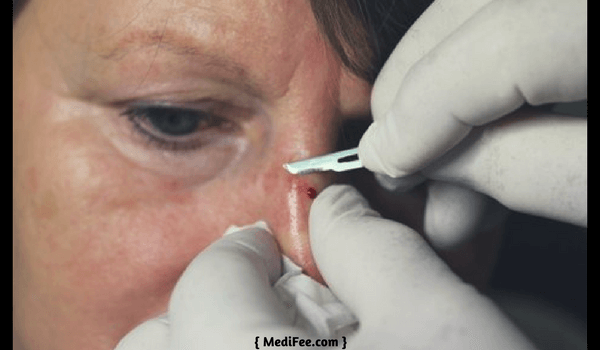
Your skin is the outer layer of the body. The cancer cells are so rapid at their growth that it wont take much time for them to spread from outer layer to the inner ones. Hence, removal becomes a necessity. Surgical removal of these cancerous skin cells can be life-saving.
Why is Skin Cancer Surgery Required?
Skin Cancer mainly occurs at the upper external layers of your body. Before the upper cancerous affected layers infect the inner ones, it is better to surgically remove them. There are surgical methods that can eliminate skin cancer by removing layer by layer of your skin unless the surgeons find a layer free of cancer.
Skin Cancer Surgery is an easy and effective way to get rid of this deadly disease. These surgeries are conducted by oncologists or dermatologists. Surgery is more commonly used as a treatment method so that skin can be removed and at the same time grafted back, if necessary. We will learn about these procedures in detail in the further parts.
Pre-operative Procedures
Pre-operative procedures of a skin cancer surgery involve certain diagnostic tests to examine and learn about the cancer which is helpful in selection of a particular surgery method to use for the patient's benefit. More importantly, your doctor requires the images of your cancer affected areas. List of diagnostic tests that are done before conducting the skin cancer surgery include:
- Skin Biopsies
- Shave Biopsy: A shave biopsy or tangential biopsy includes shaving off the upper layer of your skin with a surgical blade.
The doctor will collect these samples and send it to the lab for analysis. The shaved area will be subjected to an electric current to cauterize the wound to stop the bleeding.
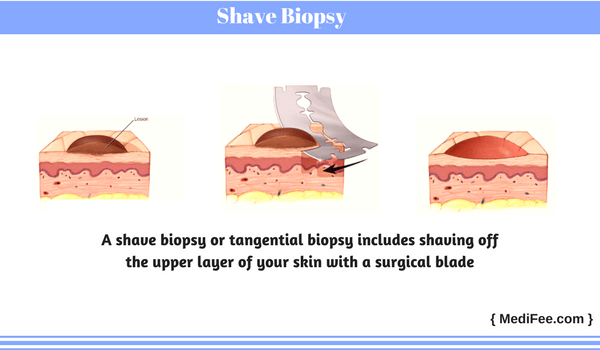
- Punch Biopsy: In a punch biopsy procedure, your surgeon will use a cookie cutter like tool to cut a deep sample of your skin.
This is done by punching the tool against your skin until it cuts all the required skin layers. A small sample is collected and the wound is sutured together.

- Incisional & Excisional Biopsies: A tumor can either emerge out of your skin or can grow deeper under your skin. Based on this, your doctor can use an incisional or an excisional biopsy. In these types, a surgical knife is used to cut through your skin.
Using this instrument, a sliver of your skin is removed for analysis and the cuts are stitched back together. Incisional biopsy includes removal of only a portion of the tumor whereas excisional biopsy removes the entire tumor. Hence, most of the time, an excisional biopsy method is preferred for a suspected skin cancer disease.
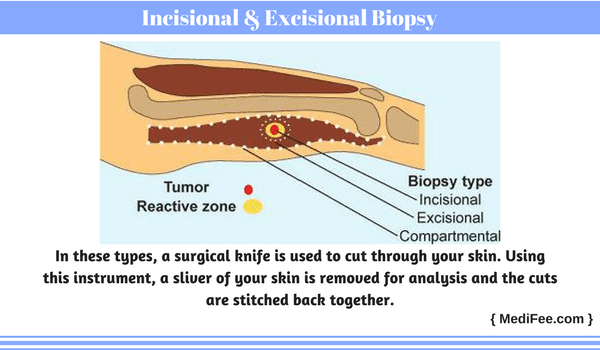
- Optical Biopsy: Reflectance Confocal Microscopy (RCM) is one of the newly introduced biopsy method. It does not include cutting samples of skin. It only uses non-invasive visualization technique of your epidermis and its lower layers.
- Fine Needle Aspiration (FNA) Biopsy: The aim of FNA is to target the lymph nodes present around the moles or cancerous tumors. This process involves using a hollow needle to remove the tumor or lymph nodes.
This needle is quite small as compared to the needle used for blood tests. This test usually is painless and does not leave scars on the injected area. Lymph nodes present just under the skin are easy to locate. But, those deep down in other parts of the body like liver may require a CT scan to guide the needle into that area
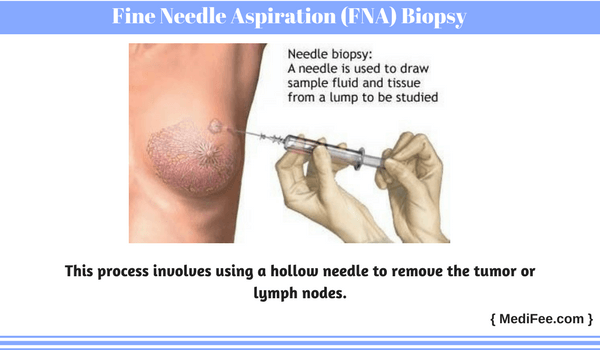
- Surgical Lymph Node Biopsy: This process is mainly conducted to remove an enlarged lymph node using a small incision. If the lymph node is deep inside the body, the patients needs to be sedated first before this process is performed. For lymph nodes located just under the skin, a local anesthesia can be given.
- Sentinel Lymph Node Biopsy: If skin cancer has been detected and it shows some concerning features, there can be a possibility that cancer has spread to the surrounding lymph nodes. At such times, treatment options get affected. Certain tests are then conducted to find about affected lymph nodes. Such lymph nodes are named as sentinel nodes.
- Shave Biopsy: A shave biopsy or tangential biopsy includes shaving off the upper layer of your skin with a surgical blade.
- Lab Tests After Biopsies
The pathologists are responsible for analysis and examination of the collected biopsy samples. More often, skin samples are examined by a dermatologist. If skin cancer is detected in the collected skin samples, the pathologist will learn more about the thickness of the tumor and its mitotic rate (rate to measure how swiftly cancer cells grow and divide). These factors notify the stage of melanoma (tumor associated with cell that form melanin), which is useful in determining the surgery options.
- Tests to Determine the Changes in Genes
For advanced skin cancer patients, the biopsy samples are tested to check if the cells have mutated in certain genes, for example, BRAF gene. Half the melanomas have BRAF mutated genes. Some newly introduced medicines are known to work on this type of skin cancer. Hence, this test plays an important role in deciding about the surgery options.
- Imaging Tests
Imaging tests include magnetic fields, X-rays or radioactive substances to generate images of the internal parts of your body. These are mainly conducted to check for the possible spread of skin cancer to lymph nodes or other parts of the body.
- X-ray of the chest: Chest X-ray can be required to check if cancer has affected the lungs.
- Computer Tomograpy (CT) Scan: Detailed, cross-sectional images are achieved using a CT scan. Here, X-rays are used to create images. Unlike a regular X-ray, CT scans gives detailed pictures of the soft tissues of the internal organs. It can show if the organs like liver have developed suspicious spots, or if lymph nodes have enlarged, which are signs that the skin cancer has spread.
- Magnetic Resonance Imaging (MRI) Scan: MRI scan utilizes strong magnetic fields and radio waves to generate a detailed image of various parts of the body. It provides your surgeons with necessary pictures of the inside as well as the outside structures of your skin.
- Position Emission Tomography (PET) Scan: PET scans are used to look for the possibility of cancer that might have spread to the other body parts and lymph nodes. Its is mainly used for patients who have advanced stages of skin cancer, but can also be used for patients with early stages. Surgical outcomes of early detected skin cancer are much better than for those which have advanced.
- Blood Tests
Blood tests are not part of the diagnostic tests. But, blood samples can be needed before or during the treatment, more importantly for advanced stages of skin cancer.
Blood tests are conducted before treatment to see the level of a substance called lactate dehydrogenase (LDH). If skin cancer has affected other parts of the body, then the level of LDH will be high. At such stages, cancer is difficult to treat. For such stages, your doctor may use a palliative (providing relief from the symptoms) surgery method. These blood tests are necessary for the doctor to confirm about the surgery, or else other treatment options are used.The above tests generate various reports that can help your doctor learn about all the aspects related to your cancer. These tests also helps the doctor decide about the best possible method to treat cancer.
Day Before Surgery
Day before your surgery, your doctor will discuss about how the surgical procedure is performed. Patients are given all the necessary guidelines to follow on the surgery day. One of these includes the dietary measures that must be followed before the surgery. Alcohol intake or smoking is not allowed. Patients are also asked to sign a consent form that contains the important points about the surgery.
Procedure Day
On the surgery procedure day, you will be admitted to a general room initially. Nurses will perform some blood tests to check your blood sugar levels before surgery. Blood pressure will also be checked. These tests are very important for surgery. For the surgery to run smoothly, these vital signs must be normal. If not, doctor might delay your surgery.
The surgical procedure begins with numbing your surgical sections. This is done by sedating the patients with general anesthesia. Sometimes, patients are also given certain medicines to consume before the surgery. As the surgery begins, the patient's vitals are noted from time to time. Any sudden rise or fall in the vitals can be harmful for the patient's life. Doctors make sure that the vital signs are balanced during the surgery.
With completion of the skin cancer surgery, the required area is stitched or bandaged to avoid bleeding. A cotton gauge with anti-septic solution covers up the stitched areas along with a cotton dressing to hold the gauge intact.
Methods/Techniques of Skin Cancer Surgery
Surgery falls under the main treatment category for most types of cancers. Usually surgeries are known to cure the early stages of skin cancer.Wide Excision
Skin cancers diagnosed early might require surgery to make sure that cancer has been discarded (excised) completely. Minor operation can cure cancerous cells at thin layers of the skin.
Initially, the area being operated is sedated with local anesthesia. Then the site of tumor is cut off with the small section of the nearby skin. This small section of skin is known as a margin. The rest of the wound is sutured together. This could leave a scar.The margin is examined under the microscope to make sure that no cancer cells exist at this removed edge of skin layer.
Wide excision is different from excisional biopsy. Here, the margins are wider. The marginal width depends on the thickness of the tumor. Thicker the tumor, wider is the margin extracted; both width-wise and depth-wise.
Margins also vary on the location of the tumor. For example, for tumor present on the face, the margins need to be smaller so that it does not leave a large scars. But, the drawback here is that smaller margins can increase the chances of cancer re-occurring.
Mohs Surgery
Most type of skin cancers are dealt with Mohs surgery. This surgery is performed by a dermatologist or a surgeon. In Mohs surgery procedure, the cancerous skin is removed layer by layer. Each layer is analyzed under a microscope. If cancer cells are found, the surgeon goes for another layer of the skin and removes it.
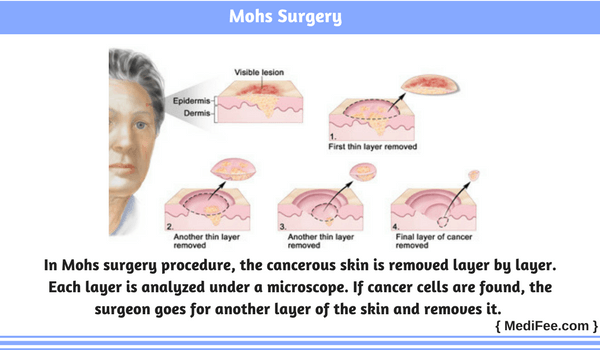
Amputation
If skin cancer has occurred on your fingers or toes and spread deeper, part or all of that section can be amputated.
Cyrosurgery
Cyrosurgery involves using a medical instrument containing liquid nitrogen. The liquid nitrogen is sprayed onto the cancer affected skin, that freezes and destroys those tissue cells.
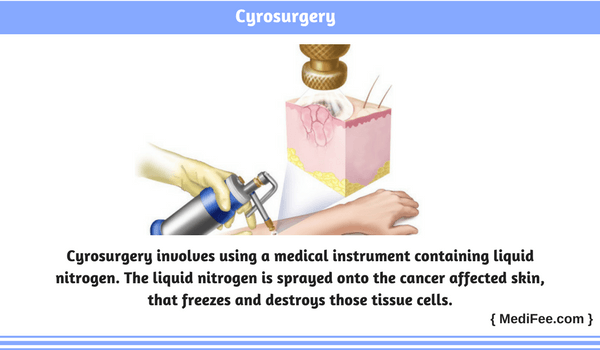
Electrodesiccation and Curettage
This surgery includes scrapping off the cancer affected tissues. This is done by using a sharp surgical tool called a curette. After the process is complete, the wound is cauterized with an electro-surgical unit.This surgery includes scrapping off the cancer affected tissues. This is done by using a sharp surgical tool called a curette. After the process is complete, the wound is cauterized with an electro-surgical unit.
Lymph Node Dissection
Lymph Node Dissection is a surgery to remove all the lymph nodes surrounding the primary cancerous region. For example, if the cancer in present on the leg, surgeon might dissect the lymph nodes near the groin, where cancer is likely to have spread.Lymph Node Dissection is a surgery to remove all the lymph nodes surrounding the primary cancerous region. For example, if the cancer in present on the leg, surgeon might dissect the lymph nodes near the groin, where cancer is likely to have spread.
In case of abnormally larger lymph nodes, a FNA or excisional biopsy is used for locating it to dissect. A sentinel biopsy can be used for the lymph nodes that aren't enlarged.
Dissection of full lymph node has long-term side effects. One of such side effect is Lymphedema. Lymph nodes under the arms are responsible for draining fluids from the limbs. If they are dissected, these fluids may get built up. This results into swollen limbs. It can be severe enough to create serious problems in the limbs and increase the risks for infections. A compression belt can be useful for such patients.
Hence, a lymph node dissection is not conducted by the surgeons unless it is really necessary. However, a sentinel lymph node biopsy is unlikely to cause such side effects.
Surgery for Metastatic Skin Cancer
If cancer has metastasized (spread) from skin to other organs of the body, it cannot be cured with surgery
If more than two areas are affected with this cancer, surgery is performed with the aim of controlling the spread instead of curing it. If 1 or more metastases have occurred and can be discarded completely, this surgery can help the patient survive longer. Removal of metastases from places like the brain can also be useful to prevent and relieve symptoms. This improves the patient's quality of life.
Post Procedure
Most patients are sedated even after the surgery as they require some time for resting after the surgery is done. To rest, your team of doctors and nurses will shift you to the general ward. Body of some patients is subjected to glucose if it is required. Also, sometimes some necessary medications are injected with it.
After your doctor has conducted surgery successfully, it is the patient's job to take care of his/her health during the post procedure period. Proper health care leads to better healing and recovery. Health care includes taking proper precautions, following all the necessary measures, visiting your doctor time to time, and many other important steps.
Precautions
After eradication of cancer from your body through surgery, your body becomes weak. It requires extra care to heal properly. Taking necessary precautions helps patients in better healing. Failing to do so can delay your healing or bring changes in your health conditions.
- Avoid excess sun exposure
- Avoid smoking
- Avoid consuming alcohol, especially when you are under medication
- Change cotton dressing on time to avoid infections
Recovery at Home
Doctor will prescribe certain cream or lotions to apply on the surgical areas of your skin. Medications must be consumed on time. Consuming a lot of medicines affects your physical health. Hence, your body requires a healthy and nutritious diet daily during this period.
Cancer affects a patient physically as well as mentally. Many patients experience great threat when they realize they have cancer. To face such stressful situations, doctors provide some therapy sessions for patients. These therapy sessions can be physical too. Meditations, yoga or similar types of therapy sessions are conducted for patients to help them manage mental and physical stress.
Follow-up Appointments
Follow-up appointments with your dermatologist or oncologists are necessary even after you have undergone a successful skin cancer surgery. It notifies your doctor about the following:
- Healing and recovery status
- Whether there is a chance of cancer coming back
- To change bandages
- Normal regular check-ups
Life After the Surgery
Life after the surgery is difficult because of the various changes undergone. Patient who has undergone a skin surgery because of cancer, experiences a lot of change in his/her outer appearance; mainly the exposed skin. For, example, skin surgery on their face, hands, or legs leads to noticeable changes after their cancer operation
Most doctors use skin grafts (skin transplant, where skin is taken from different part of your body or donor's body) or skin flaps (healthy skin or tissues that is attached to cover your wounds) in the operated areas of the skin. So the color and texture of your attached skin slightly varies from your original skin.
Risks and Complications
Every skin cancer surgery has risk factors and complications associated with it. These complications are sub-divided into various parts based on their occurrence.
Immediate Complications after Surgery
Complications that commonly occur during or just after the skin cancer surgery include:- Damage to important structures of skin, like nearby nerves or glands
- Difficulty in suturing the wound
- Bleeding
- Adverse reactions of certain medication
- Bruising
Delayed Complications after Surgery
Some complications arise within hours or after some days post-surgery. Such common complications include:- Infections around the surgical areas
- Suture reactions
- Delay in healing process
- Breakdown of the wound
- Incomplete excision
- Persistent swelling
Late Complications after Surgery
Late complications that take place after a skin cancer surgery are as follows:- Unsightly cosmetic results
- Recurrent skin cancer or other forms of cancer
- Recurrent tumors
More information related to Skin Cancer surgery
Best Onco-surgeons in India
Best hospitals for Cancer treatment in India

